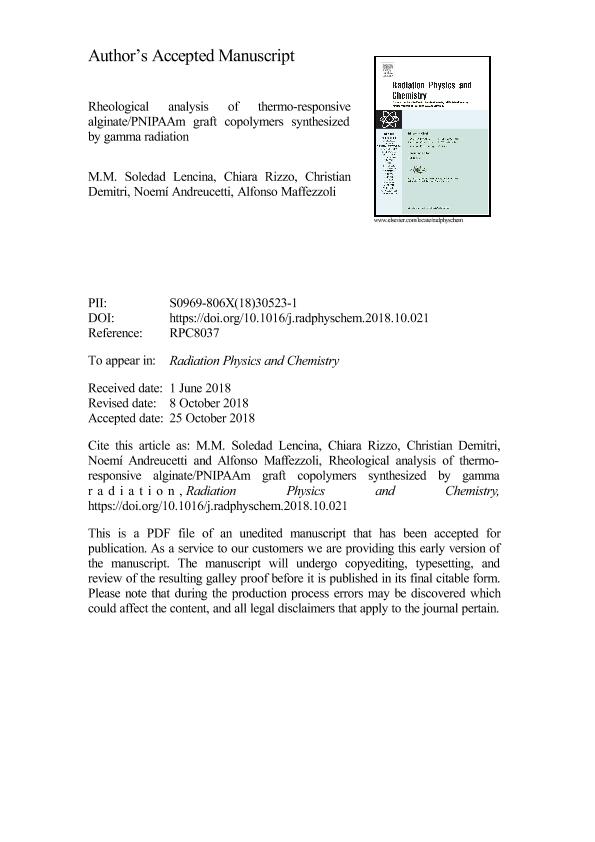Mostrar el registro sencillo del ítem
dc.contributor.author
Lencina, María Malvina Soledad

dc.contributor.author
Rizzo, Chiara
dc.contributor.author
Demitri, Chistian
dc.contributor.author
Andreucetti, Noemi Amalia

dc.contributor.author
Maffezoli, Alfonso
dc.date.available
2020-04-13T15:10:36Z
dc.date.issued
2019-03
dc.identifier.citation
Lencina, María Malvina Soledad; Rizzo, Chiara; Demitri, Chistian; Andreucetti, Noemi Amalia; Maffezoli, Alfonso; Rheological analysis of thermo-responsive alginate/PNIPAAm graft copolymers synthesized by gamma radiation; Pergamon-Elsevier Science Ltd; Radiation Physics and Chemistry (Oxford); 156; 3-2019; 38-43
dc.identifier.issn
0969-806X
dc.identifier.uri
http://hdl.handle.net/11336/102360
dc.description.abstract
Focused on biomedical applications of thermo-responsive polymers, low-doses of gamma radiation from a 60Co source were applied in a simple one-pot method to synthesize graft copolymers of alginate and poly(N-isopropylacrylamide) (PNIPAAm) with different compositions. The molar percentage of grafted NIPAAm (% molar NIPAAm) was determined by thermogravimetric analysis (TGA) and elemental analysis (EA), being the copolymer structure-property relationship studied in terms of thermo-associative and rheological behavior in aqueous solutions. The addition of more NIPAAm monomer in the initial mixture of reaction, as well as, increasing absorbed dose lead to a greater grafting. However, increasing radiation dose produces copolymers with diminished viscoelastic properties caused by the alginate backbone scission. From rheological curves, two transition temperatures, Ta and Tgel, were determined as a consequence of the thermo-responsiveness of PNIPAAm side chain. Storage (G′) and loss (G″) modulus curves undergo a slope inversion at Ta temperature, where both moduli begin to increase caused by an associative behavior of PNIPAAm domains. While, Tgel temperature is related to the onset of the gelation process at the G′/G″ crossover. In order to design samples with liquid-gel transitions close to the human body, able to form gels in situ once inoculated, it was possible to tailor both transition temperatures selecting copolymers with an appropriate PNIPAAm content and optimizing the copolymer concentration in the aqueous solution. A good agreement between transition temperatures and viscoelastic properties was achieved for 5 wt% aqueous solutions of copolymers with low NIPAAm content synthesized at the lowest absorbed dose (0.5 kGy).
dc.format
application/pdf
dc.language.iso
eng
dc.publisher
Pergamon-Elsevier Science Ltd

dc.rights
info:eu-repo/semantics/openAccess
dc.rights.uri
https://creativecommons.org/licenses/by-nc-sa/2.5/ar/
dc.subject
Alginate/PNIPAAm copolymers
dc.subject
Gamma radiation
dc.subject
Rheology
dc.subject
Thermo-responsive
dc.subject.classification
Físico-Química, Ciencia de los Polímeros, Electroquímica

dc.subject.classification
Ciencias Químicas

dc.subject.classification
CIENCIAS NATURALES Y EXACTAS

dc.title
Rheological analysis of thermo-responsive alginate/PNIPAAm graft copolymers synthesized by gamma radiation
dc.type
info:eu-repo/semantics/article
dc.type
info:ar-repo/semantics/artículo
dc.type
info:eu-repo/semantics/publishedVersion
dc.date.updated
2020-02-26T19:38:46Z
dc.journal.volume
156
dc.journal.pagination
38-43
dc.journal.pais
Países Bajos

dc.journal.ciudad
Amsterdam
dc.description.fil
Fil: Lencina, María Malvina Soledad. Consejo Nacional de Investigaciones Científicas y Técnicas. Centro Científico Tecnológico Conicet - Bahía Blanca. Instituto de Física del Sur. Universidad Nacional del Sur. Departamento de Física. Instituto de Física del Sur; Argentina
dc.description.fil
Fil: Rizzo, Chiara. University of Salento; Italia
dc.description.fil
Fil: Demitri, Chistian. University of Salento; Italia
dc.description.fil
Fil: Andreucetti, Noemi Amalia. Universidad Nacional del Sur. Departamento de Química; Argentina
dc.description.fil
Fil: Maffezoli, Alfonso. University of Salento; Italia
dc.journal.title
Radiation Physics and Chemistry (Oxford)

dc.relation.alternativeid
info:eu-repo/semantics/altIdentifier/url/https://www.sciencedirect.com/science/article/abs/pii/S0969806X18305231
dc.relation.alternativeid
info:eu-repo/semantics/altIdentifier/doi/http://dx.doi.org/10.1016/j.radphyschem.2018.10.021
Archivos asociados
